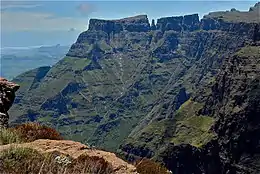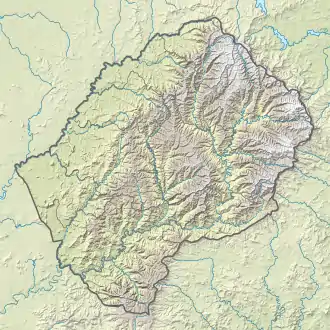uKhahlamba-Drakensberg Park
The uKhahlamba-Drakensberg Park is a protected area in the KwaZulu-Natal province of South Africa, covering 2,428.13 km2 (938 sq mi), and is part of a world heritage site.[2] The park includes Royal Natal National Park, a provincial park, and covers part of the Drakensberg, an escarpment formation with the highest elevations in southern Africa.
| UNESCO World Heritage Site | |
|---|---|
 uKhahlamba or Drakensberg in Royal Natal National Park (which is part of the uKhahlamba Drakensberg Park) | |
| Location | KwaZulu-Natal, South Africa |
| Part of | Maloti-Drakensberg Park |
| Criteria | Cultural and Natural: (i)(iii)(vii)(x) |
| Reference | 985bis-001 |
| Inscription | 2000 (24th session) |
| Extensions | 2013 |
| Area | 242,813 ha (600,000 acres) |
| Coordinates | 29°23′00″S 29°32′26″E |
| Official name | Natal Drakensberg Park |
| Designated | 21 January 1997 |
| Reference no. | 886[1] |
 Location of UKhahlamba-Drakensberg Park near the border of Lesotho  UKhahlamba-Drakensberg Park (KwaZulu-Natal)  UKhahlamba-Drakensberg Park (South Africa) | |
The park and the adjoining Sehlabathebe National Park in the Kingdom of Lesotho are part of the Maloti-Drakensberg Park, which was first declared a World Heritage Site on 30 November 2000. It is described by UNESCO as having "exceptional natural beauty in its soaring basaltic buttresses, incisive dramatic cutbacks, and golden sandstone ramparts... the site’s diversity of habitats protects a high level of endemic and globally threatened species, especially birds and plants... [and it] also contains many caves and rock-shelters with the largest and most concentrated group of paintings in Africa south of the Sahara".[2] The paintings mentioned are parietal art, some of which may date to 40,000 or 100,000 years ago.
Plans to boost tourism in the area include a long-awaited cable car project by the KZN Economic Development, Tourism, and Environmental Affairs Department.[3]
Fauna
The Drakensberg area is characterized by a high level of endemism of both vertebrates and invertebrates.[4][5]
Conservation
Most of the higher South African parts of the Drakensberg escarpment formation have been designated as game reserves or wilderness areas. The uKhahlamba-Drakensberg Park is also in the List of Wetlands of International Importance (under the Ramsar Convention). Adjacent to the park is the Cathkin Estates Conservation and Wildlife Sanctuary, which spans 1,044 ha (10 km2) of virgin grassland and represents the largest privately-owned game park in the KwaZulu-Natal Drakensberg region.[6]
References
- "Natal Drakensberg Park". Ramsar Sites Information Service. Retrieved 25 April 2018.
- "Maloti-Drakensberg Park". UNESCO World Heritage Centre. Retrieved 2015-08-11.
- http://www.5stardurban.co.za/drakensberg-cableway-task-team/
- Barraclough, D.A. & McAlpine, D.K. 2006. Natalimyzidae, a new African family of acalyptrate flies (Diptera: Schizophora: Sciomyzoidea). African Invertebrates 47: 117-134. "Archived copy". Archived from the original on 2007-02-06. Retrieved 2009-10-29.CS1 maint: archived copy as title (link)
- Plisko, J.D. 2009. Pre-testical spermathecal pores and unusual setal arrangement in the South African endemic microchaetid earthworms of presumed Gondwanan origin (Oligochaeta: Microchaetidae). African Invertebrates 50 (2): 237-254. "Archived copy". Archived from the original on 2011-10-04. Retrieved 2011-10-04.CS1 maint: archived copy as title (link)
- "Cathkin Estates". Gems Estate Management. Archived from the original on 2015-09-21. Retrieved 2015-08-11.
External links
| Wikivoyage has a travel guide for uKhahlamba / Drakensberg Park. |